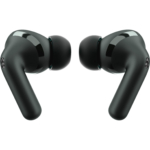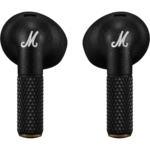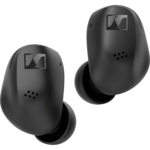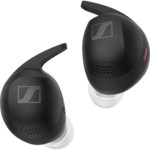You actively opt for a dedicated headphone amplifier because, after all, it requires separate cabling from the source device. Conversely, you might say: If you invest money in high-quality headphones for stationary use and possibly even use them as a daily work tool, you would do well not to skimp on the amplifier. SPL’s Phonitor One masters its self-imposed task with a brilliant price-performance ratio. This applies to both the model presented here and the version with supplementary USB interface. As a special feature, the integrated Phonitor Matrix offers real added value in the assessment of sound signals designed for loudspeaker output, ultimately providing improved assurance of sound compatibility.
For smartphones and inexpensive stationary audio devices, but also in the studio, one should refrain from making overly high demands on integrated headphone amplifiers. They are part of an overall cost calculation for the product and often, in a sense, more of an accessory than a selling point. Accordingly, a dedicated headphone amplifier can certainly improve your listening experience, since it is a piece of technology that devotes its full attention to precisely this task. This is the case with the Phonitor One from SPL.
This medium-sized, flat, black desktop device was developed at SPL in Niederkrüchten and manufactured in Germany. The manufacturer classifies it in their studio range. On the front, there is a large volume control, a source switch (Line 1/Line 2) and a 6.3 mm headphone output with a small control for the so-called crossfeed function (see below).
At the rear, there is the input for the external plug-in power supply, the on/off switch and the two stereo inputs. One pair is equipped with RCA connectors for unbalanced line levels, the other with balanced 6.3 mm jack sockets. The latter work with a higher reference level of +4 dBu, as is usual in a studio setting – use with unbalanced sound sources is possible, but is accompanied by a level drop of 6 dB due to the system.
The Phonitor One is based on a simple concept and is recommended wherever a high-quality headphone amplifier is needed. This might be in the living room or, in a professional environment, such as a mixing console, editing suite, computer or at a second monitoring position, for example for the producer. The headphone amplifier can also be used for recordings, as long as no mixing of two signals (feed, musician’s direct signal) is required. Lastly, the Phonitor One is not designed for comparisons or the use of two headphones.
In practice
The Phonitor One focuses on a single task: the high-quality processing of input signals for use with headphones. Thus, the emphasis is on sound quality and adequate performance. For signal amplification, SPL relies on two audiophile-grade Burr-Brown OPA 2134 SoundPlus operational amplifiers and other high-quality components. The result is a very low inherent noise and an equally impressive and powerful sound image, which is brought to the output by a Class A/B amplifier stage with thermally coupled field-effect transistors.
The all-important power supply is provided by a 12 V plug-in power supply unit (1.5 amps), but is processed internally to a working current of +/-17 volts for the audio range, in order to keep the necessary dynamics and power available. In practice, even low-impedance models such as the AKG K702 could be operated at sufficient levels. Nevertheless, the Phonitor One is not quite loud enough.
The two stereo inputs offer the possibility of switching immediately to an alternative source, such as a CD player, in addition to the balanced connection.
If you want to integrate digital sound sources, the Phonitor One can also be purchased as a “Phonitor One d” model for an additional 200 Euros with an integrated 32-bit DA converter, which is selected via a USB interface with a class-compliant driver and supports sampling frequencies up to 784 kHz and bitstreams up to DSD 256 – a worthwhile surcharge for corresponding applications. Of course, special attention should be paid to the function called …
Crossfeed
An SPL development is the analogue Phonitor Matrix, which aims to give headphones the characteristics of loudspeaker reproduction. The problem is that virtually every published sound recording is mixed through loudspeakers and optimised in terms of their level components, distribution in the stereo panorama and depth gradation. In fact, playback through loudspeakers also corresponds more to the listening experience in real life, where sound sources always reach both ears, with a certain difference in propagation time as well as a complementary physiognomically conditioned filtering. These parameters are relevant for our perception of spatiality and distances. However, they are omitted in headphones due to their perfect channel separation. And so it is hardly surprising that listening differences arise as a result.
When using headphones, the stereo panorama and room components are fanned out noticeably more broadly and spectrally. At the same time, the bass components of the side signals become more pronounced and, conversely, the midrange components become somewhat less prominent.
The Phonitor Matrix from SPL now addresses these disadvantages with a circuit that offers three parameters: the filtered crossfeed between the stereo channels, the placement angle of the speakers and a level compensation of the mid signal.
Only the crossfeed parameter is adjustable in the Phonitor One. At maximum, up to 30 per cent of the opposite signal can be added. The latter is increasingly filtered in the high frequencies from 500 Hz and completely faded out above 10 kHz. The angle of the speakers, which influences the delay time, is preset to the usual 30° corresponding to 250 µs, while the centre signal is lowered by a fixed 1 dB in order to correctly embed the stereo centre again after using the crossfeed parameter.
Sound
Due to its low noise and neutral gain, the Phonitor One delivers a wonderfully balanced sound result with high detail resolution, dynamics and an intimacy rarely found on standard solutions. Apart from the crossfeed function, the Phonitor One behaves as you would expect from an amplifier: sound-neutral, without colouration and fast in response. There’s not much more to say.
The crossfeed circuit actually has a significant influence on the sound. It is continuously adjustable and is removed from the signal path in the minimum position. In fact, the results are amazing: the audio signal gains “size” and “naturalness” in the sense of improved three-dimensionality. The sound detaches itself from pure localisation in the head and appears more realistic in its spatiality. At the same time, the controls offer the possibility to adjust the “correction” as needed, since the perfect stereo separation and the resulting over-wide panorama of a typical headphone reproduction are not per se negative characteristics. Personally, I often liked medium values best, as the maximum setting was a bit too intensively filtered and not pronounced enough in the room. By the way, the Phonitor Matrix does not achieve a real front localisation as with loudspeakers, but it does achieve a practical approximation to the sound image from loudspeakers. In mixes with an artificially expanded stereo image (for example, “Snap” with “World in My Dub”), certain elements of the mix were increasingly lost when the crossfeed function was used, so it is definitely advantageous to be able to control the intensity.
Technical specifications
- Ear couplingAmplifier
Special features
- All technical data can be found on SPL's product page.










































Do you have any comments on the headphone output impedance? It is 20ohms on this device and it should NOT match well with 62ohm AKG K702 according to the 1/8 impedance guideline.